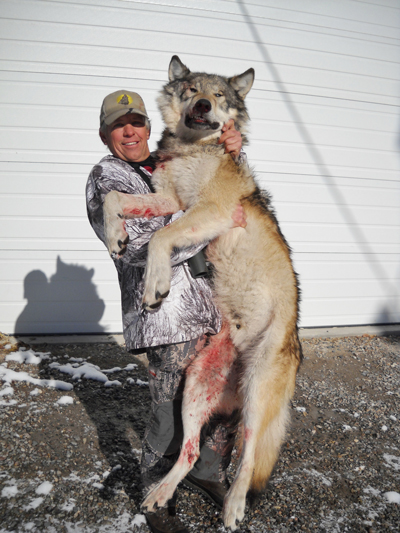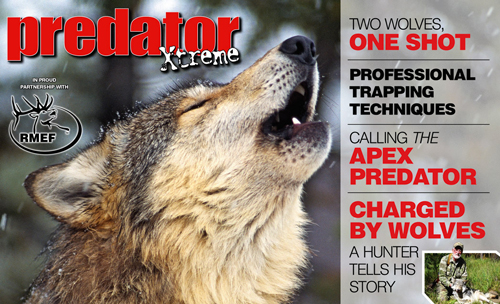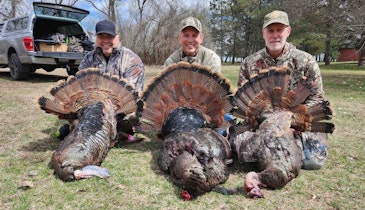Featured in the Predator Xtreme WOLF Issue, a FREE Digital Magazine
As an avid hunter in the lower areas of the Yellowstone ecosystem, I knew it would only be a matter of time before the area where we hunt elk would feel the impact of the wolves. My children are fourth-generation elk hunters in the Absaroka Range, and as we predicted, observing the decrease in the elk and moose populations in this area has been a hard pill to swallow. It was conflicting to know that such a rich hunting ground was being damaged, while also acknowledging that hunters are true conservationists and that wolves are a keystone species that ensures an ecosystem is balanced and healthy.
In the summer of 2012, Wyoming was finally granted permission to manage wolves through trophy hunting. My two sons and I purchased our licenses, along with more than 4,000 other hunters, and were excited at the chance to hunt this formidable opponent. We have competed in numerous predator-hunting competitions and harvest about 35 coyotes annually. We knew that this challenge would be a test of our predator-hunting skills; something to up the ante. I researched the different wolf packs in the state every evening, along with talking to numerous biologists and wardens with the Wyoming Game and Fish department. Along with the continuous research and scouting, I manufactured a couple of wolf stretchers.
I started my hunting on opening day of the season northeast of the small town of Dubois. Riding horses into the Absaroka Mountains, I spent my time calling openings and drainages using a mixture of elk calls and wolf communicative howls. Before going afield, I had read conflicting reports about calling wolves, with some people claiming how easy it was to call them in, while others explaining the difficulties of luring in this wary and elusive animal. I found the latter to be true after riding more 120 miles and calling every opening and drainage I came across in northwestern Wyoming. I only doubted my tactics temporarily, but I decided to stick with my calling routine and stay true to the sport, knowing that harvesting a wolf in this fashion would be a great test of skill.
On one occasion I was calling a small mountain meadow. About 30 minutes into the set, a sow grizzly and three cubs suddenly stormed within 30 yards of me and my call. I fumbled for my transmitter before quickly turning the prey sounds off and sat patiently for them to lose interest and skirt back into the cover of the trees. This hadn’t been the first time I had come into contact with grizzlies in this country. In fact, only a week later, I called in another grizzly. This time it was a lone boar that vocally expressed his annoyance from a group of pines downwind from our horses.
After calling for 16 total days and running into some grumpy inhabitants of the mountains, the closest I came to success was bringing in a lone wolf that howled at me a couple hundred yards away from the protection of thick fallen timber. I decided that my next hunt would be north of the small mountain town of Crandall, about 15 miles south of the Montana border. I knew that many wolves came into that area in the winter, following the migrating elk herds that travel out of Yellowstone National Park.
There was a great feeling of anticipation on Nov. 10, 2012, as I drove up the Lily Lake road, which was freshly covered by 2 inches of snow. After investigating the area, I discovered 100 head of elk bedded down on a high, sage-covered ridge. I watched the elk for a moment and knew I had to get as close to the herd as possible and find a spot to call. As I was approaching the elk herd, I saw their tracks in the freshly fallen snow. On top of all these elk tracks were the tracks of four wolves. My excitement elevated — I knew this would be a great opportunity to finally call in a wolf.
 After quietly moving into range of the elk herd, I set my Wildlife Technology call about 40 yards in front of me in the sagebrush and rested my back against a large stand of lodgepole pines. I set up my BOGgear BOG-POD and took the scope cover off my 7mm Gunwerks rifle. I was pleased with the topography that allowed a shot at the ranges of 500, 150 and 50 yards. I positioned my rifle toward the area that I thought the wolves would be coming from, and the snow started to lightly fall as the mountains around me began to sock in. I started calling using soft cow elk calls mixed with raven calls. The elk, a couple hundred yards away, began to stir as I started calling a bit more aggressively by adding in some deer distress sounds about 15 minutes into the set. The elk approached me within 30 yards and curiously watched the call before a couple of young bulls began taking turns bugling. I knew this could only help, and felt as though the wolves might be getting nearer. I knew that if the wolves were at the bottom of the drainage they would hear the calls, but they weren’t responding to the predatory sounds I was playing. I decided to take a chance and use some howling coyote calls to bring the four wolves to the edge of the trees. This startled the elk, but their curiosity kept them near. After about 10 minutes of silence I used a male and female wolf duet to trigger the wolves’ instinctive territorial nature. The elk immediately changed their attention to the thick trees at the end of the down-sloping meadow. I knew they had noticed something in the trees beneath them, and when the lead cow of the herd let out a shrill alarming bark, I knew the wolves were approaching.
After quietly moving into range of the elk herd, I set my Wildlife Technology call about 40 yards in front of me in the sagebrush and rested my back against a large stand of lodgepole pines. I set up my BOGgear BOG-POD and took the scope cover off my 7mm Gunwerks rifle. I was pleased with the topography that allowed a shot at the ranges of 500, 150 and 50 yards. I positioned my rifle toward the area that I thought the wolves would be coming from, and the snow started to lightly fall as the mountains around me began to sock in. I started calling using soft cow elk calls mixed with raven calls. The elk, a couple hundred yards away, began to stir as I started calling a bit more aggressively by adding in some deer distress sounds about 15 minutes into the set. The elk approached me within 30 yards and curiously watched the call before a couple of young bulls began taking turns bugling. I knew this could only help, and felt as though the wolves might be getting nearer. I knew that if the wolves were at the bottom of the drainage they would hear the calls, but they weren’t responding to the predatory sounds I was playing. I decided to take a chance and use some howling coyote calls to bring the four wolves to the edge of the trees. This startled the elk, but their curiosity kept them near. After about 10 minutes of silence I used a male and female wolf duet to trigger the wolves’ instinctive territorial nature. The elk immediately changed their attention to the thick trees at the end of the down-sloping meadow. I knew they had noticed something in the trees beneath them, and when the lead cow of the herd let out a shrill alarming bark, I knew the wolves were approaching.
My coyote-hunting instincts kicked in as I saw a glimpse of movement just behind the small ridge 150 yards away. I looked through my Huskemaw scope to see a large gray wolf loping near my position. The large canine was expressing dominant posture with his tail straight up and the hair on the back of his neck bristled. My crosshairs were already fixed and steady on the wolf’s chest. There was a moment where time slowed down and thoughts began to run through my head. It was my 18th day of hunting. After all of the miles spent on horseback and the beautiful Wyoming country covered, and all the effort and time put into hunting this magnificent creature, this moment seemed all too quick and easy. All of the preparation, excitement and frustration led me to this final moment when everything just clicked.
I squeezed the trigger and dropped the wolf at 150 yards. I exuberantly gathered my backpack and call before trotting down through the sagebrush to examine the trophy. I was immediately astounded by the size of him. I looked the wolf over to find a broken left canine and a cataract in the right eye. This thing wasn’t just an average wolf, but a long-lived and beautiful alpha male. I felt so excited that I wanted to yell. Something told me that this wouldn’t be right, so instead I let out a long howl that echoed off the frosty trees around me. As I stood by the wolf, I couldn’t help but smile as the other three wolves howled back from the ridge above me. It was this moment of elation that completed my fall goal.
The sun was starting to set and the snowfall was accumulating. It was unfortunate that I didn’t capture any pictures of the wolf where I shot it, but at 5 feet, 7 inches tall, and weighing 170 pounds, it took all I had to carry the 130-pound canine back to my truck miles away through fallen timber.
On the six-hour drive back to my hometown, I couldn’t help but think about wolves, hunting and conservation. I believe that hunters have the most appreciation for the game they are after. It is only when you spend time in their habitat, learning their behavior, that you fully gain an understanding of the animal.
Wolves are a controversial subject in the West, but it is the duty of conservationists and sportsmen alike to manage these animals. Seeing wolves once again roam the Rocky Mountains of Wyoming, Idaho and Montana brings back a greater sense of wilderness to the areas that we love so much, and that make our states so great. The fact that wolves are being harvested means success for conservationists and wildlife lovers, as well as for the sportsmen and ranchers.
For more wolf hunting gear, tactics, tips, and stories check out the Predator Xtreme WOLF Issue.
Never miss an issue!







